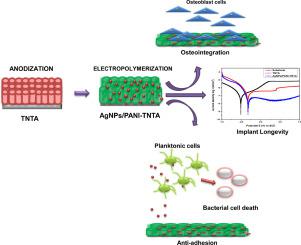Surfaces and Interfaces ( IF 5.7 ) Pub Date : 2020-12-21 , DOI: 10.1016/j.surfin.2020.100892 Agilan Perumal , Saranya Kannan , Rajendran Nallaiyan

|
The premature failure of titanium orthopaedic implant occurs mainly due to infections and non-reunion of fractures. Encouragingly, the controlling of infections and fracture reunion was effective with metal nanoparticles and conducting polymers. In this present work, the nanocomposite of silver nanoparticles incorporated polyaniline (PANI) on TiO2 nanotube arrays (TNTA) was fabricated by electropolymerization. The nanocomposite had effectively declined the rate of biofilm formation and enhanced cellular responses. Moreover, the corrosion rate was regressed that undermines the release of titanium wear-out particles. Collectively, the work illustrates the significant usage of multifunctional nanocomposite for achieving the synergetic effect on antibiofilm, antibacterial and better osseointegration.
中文翻译:

在TiO 2纳米管阵列上结合了聚苯胺的银纳米颗粒:增强生物相容性和抗生物膜的纳米复合材料平台
钛整形外科植入物的过早失效主要是由于感染和骨折不愈合所致。令人鼓舞的是,金属纳米颗粒和导电聚合物可有效控制感染和骨折重聚。在本工作中,通过电聚合制备了在TiO 2纳米管阵列(TNTA)上结合了聚苯胺(PANI)的银纳米颗粒的纳米复合材料。纳米复合材料有效地降低了生物膜形成的速率并增强了细胞反应。此外,腐蚀速率下降,破坏了钛磨损颗粒的释放。总的来说,这项工作说明了多功能纳米复合材料在实现抗生物膜,抗菌和更好的骨整合协同作用方面的重要用途。











































 京公网安备 11010802027423号
京公网安备 11010802027423号